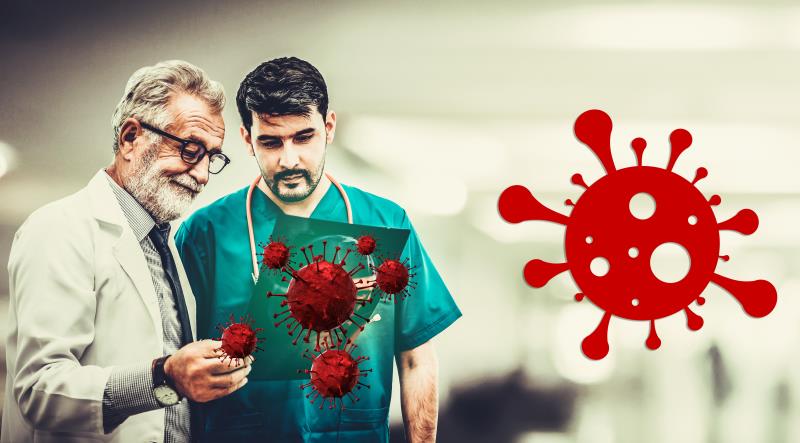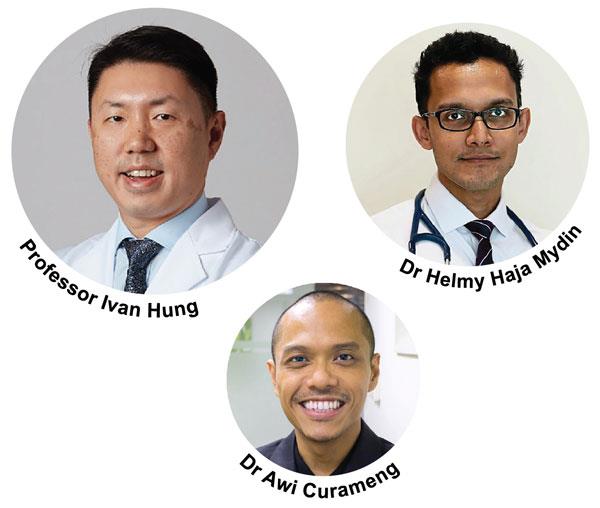10 things doctors should know about COVID-19





Herd immunity will not work in the novel coronavirus disease (COVID-19), according to an infectious disease expert who addressed over 3,600 primary care physicians (PCP) from Asia Pacific at the inaugural webcast of the MIMS COVID Conversations Series.
Professor Ivan Hung, chief of the Division of Infectious Diseases at the University of Hong Kong, Hong Kong, China, stressed that herd immunity is only possible if majority of a certain population have already developed immunity—either through vaccination or natural immunity—and “definitely will not work in a novel virus” such as SARS-CoV-2, the causative agent of COVID-19.
This is one of several points he raised during the first MIMS-sponsored webcast, COVID-19: What It Means To Your Clinic, which sought to translate the fast-evolving science of COVID-19 patient care into practical clinical pearls for the Asian PCP and provide insights on how clinicians can prepare for the next outbreak.
In his lecture, Hung presented 10 things that general practitioners and family doctors should be aware of in the fight against COVID-19. He was joined by discussant Dr Helmy Haja Mydin, a consultant in internal and respiratory medicine at Pantai Hospital in Kuala Lumpur, Malaysia. Dr Awi Curameng of MIMS was the event moderator.

1. Epidemiology
Hung began by analysing the incidence and distribution of the novel disease, which was initially reported at the beginning of January 2020 in Wuhan, the epicenter of the COVID-19 outbreak in China. According to him, the outbreak worsened when it coincided with the Lunar New Year, during which time “lots of people traveled” and “went back home” to celebrate with their families.
On 19 March 2020, COVID-19 cases stood at 218,584 in 157 countries across the globe, with a mortality rate of 4.1 percent. This shot up to nearly 4 million cases by 8 May 2020, affecting 227 countries, with a mortality rate of 6.8 percent. The US, Spain, Italy, the UK, and Russia were the countries with the highest number of infected individuals.
“This is something that we absolutely did not expect,” Hung said.
2. Virology
The spike protein on the surface of the novel virus explains its “very different transmission and rapid replication,” explained Hung, who further described SARS-CoV-2 as a positive sense, single stranded RNA CoV, Beta CoV lineage B.
The virus is 79.5-percent similar to SARS-CoV that emerged in 2003, except for the spike protein, and is 96-percent similar to the bat coronavirus. These parallels in characteristics suggest that SARS-CoV-2 likely occurred from nature, Hung noted.
3. Transmission
When a person has acquired the virus, a window period of about 3–4 days will ensue, in which “there is no detectable virus that can be found in the patient.” Tests done during this period will then lead to a negative result.
“This is usually followed by a few days of so-called asymptomatic shedding, where there will be detectable viral RNA in the secretion and other specimen,” said Hung, adding that patients will most probably not show any symptoms. For some cases, the incubation period can last for up to 24 days.
Of note, infected patients with no symptoms will continue to shed and transmit the virus to others. In studies involving returnees from the Princess Diamond Cruise wherein several tourists acquired COVID-19 during the trip, Hung and colleagues found that for each symptomatic case, there were about two to three asymptomatic cases.
4. Clinical presentations
Symptomatic patients normally present with symptoms similar to that of influenza and other respiratory viruses, and that include fever, fatigue, and other respiratory symptoms such as sneezing, runny nose, sore throat, dry cough, or shortness of breath. Some could also have diarrhoea, while those with deteriorating health could develop pneumonia.
Other clinical characteristics include myalgia, decreased kidney function, reduced white blood cells, and exacerbation of underlying diseases such as coronary artery disease (CAD) and chronic obstructive pulmonary disease (COPD).
Complications may arise in some COVID-19 patients, including the development of respiratory failure due to severe pneumonia, acute cardiac or acute kidney injuries, multiple organ failure, hepatitis or liver failure from treatment, and sepsis. Infected children may also develop Kawasaki disease, while those with severe disease may require intensive care and invasive or noninvasive ventilator support.
5. High-risk populations
Most patients with COVID-19 are between 25 and 50 years of age, but those above 65 years are considered high-risk and may require intensive care, according to Hung. Half of these cases may deteriorate, especially those who present late to the hospital. In contrast, young patients will be “relatively risk-free,” especially children who usually have very mild symptoms or are asymptomatic.
Patients with comorbidities, like diabetes mellitus, respond “very slowly” to treatment and are likely to develop severe pneumonia. Other high-risk groups include those with underlying cardiovascular disease, COPD, malignancy, chronic liver disease, and who are immunosuppressed. [Lancet 2020;doi:10.1016/50140-6736(20)30183]
6. Diagnosis
Identifying patients who are infected with SARS-CoV-2 is “very, very important” as this allows governments to “identify patients who are symptomatic or asymptomatic” and subsequently “quarantine or hospitalize” them.
Most diagnoses are done by RT-PCR testing, targeting on the RNA-dependent RNA polymerase (RdRp) or the surface spike protein or the nucleocapsid, according to Hung. In terms of sampling, it could range from invasive methods like nasopharyngeal aspirate (NPA) and nasopharyngeal swab (NPS) to less invasive ones like oropharyngeal saliva testing, sputum, blood, stool, urine or even the conjunctiva.
For recent past infection, serological testing of the immunoglobulin (Ig) G or IgM can be performed as well as neutralizing antibody testing. Serological testing is normally applied from day 7 onwards to confirm if a patient has developed antibodies against COVID-19.
“If you perform a serology testing too early, probably in the first week, most patients would be negative,” said Hung, adding that radiological findings may also be used for those not presenting with respiratory symptoms.
7. General management
It is also important to have early diagnosis (ie, travel history, contact with confirmed patients, patients with upper respiratory tract symptoms, and screening of high-risk patients), early hospitalization, and early treatment for symptomatic patients.
“By hospitalizing these patients, you actually quarantine [them] and stop them from shedding the virus in the community,” said Hung. “And of course, early treatment will allow you to prevent complications that usually happen in the second or third week.”
Herd immunity is not an option, he added. “If you are looking for herd immunity, you are looking at 60–70 percent of the population being infected. Basically, your health system will not be able to sustain such a large number of patients being infected … Your health system will be overwhelmed.”
8. Specific treatments
Remdesivir leads the armament of therapies that are currently available and has been shown to accelerate recovery of patients with advanced COVID-19. Lopinavir-Ritonavir is another potential treatment, although studies have reported no major improvement in patients. [www.nih.gov/news-events/news-releases/nih-clinical-trial-shows-remdesivir-accelerates-recovery-advanced-covid-19; N Engl J Med 2020;382:1787-1799]
Hydroxychloroquine has also been used in some cases and appears to be effective when combined with other treatments. Furthermore, convalescent plasma has been able to suppress the viral load and to immunomodulate patients with severe COVID-19. (See also: 10 treatments for COVID-19)
Hung stressed that any antiviral treatment is more effective when given during the early phase of the disease. “If you can give that to a patient with mild [symptoms] or without complication, [then] the outcome will be better.”
9. Infection control
Hung said that controlling the spread of SARS-CoV-2 is “extremely important,” citing experiences in Hong Kong where the government has a “very, very intense surveillance,” tight border control and screening, contact tracing, and home and centralized quarantine. In addition, “everyone is practising universal face masking” and social distancing.
“Infection control measures are definitely very important to allow you to identify cases and put them in quarantine, and also for those symptomatic cases to be hospitalized for treatment” to prevent a local community outbreak, he said. Other measures include hand hygiene and seeing a doctor when experiencing respiratory tract symptoms.
10. Vaccine
Currently, there are six vaccines in clinical evaluation, with another one set to start soon. About 70 candidates are in preclinical evaluation. “Hopefully, we’ll be having a vaccine available later next year after they have gone through a successful phase I and phase II clinical trials,” Hung said.
When asked about some guidance on how PCPs could open their clinics in the post-outbreak period, Helmy said that physicians “need to make sure that unnecessary stuff is removed” from the clinic, such as magazines or toys in the waiting area, which can potentially pass the virus.
In addition, he stressed that the “staff are adequately protected with face shields” and masks. “If you have someone who is entering the clinic with relevant symptoms, then you might not want to get them into your normal clinic in the first place, and you may want to have an arrangement whereby people who have got symptoms are assessed in a different area with perhaps additional PPEs (personal protective equipment) both for your staff and people who are dealing with patients.”
Hung concurred with Helmy. He emphasized the importance of protecting “your own staff and yourself,” checking the temperature of patients and personnel in the clinic twice daily and wearing surgical mask. In addition, he said that those with upper respiratory tract symptoms or fever should be placed in a separate room, if there is one available.